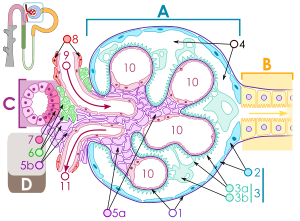
Intraglomerular mesangial cell
Encyclopedia

Renal corpuscle
In the kidney, a renal corpuscle is the initial blood-filtering component of a nephron. It consists of two structures: a glomerulus and a Bowman's capsule. The glomerulus is a small tuft of capillaries containing two cell types. Endothelial cells, which have large fenestrae, are not covered by...
of a kidney
Kidney
The kidneys, organs with several functions, serve essential regulatory roles in most animals, including vertebrates and some invertebrates. They are essential in the urinary system and also serve homeostatic functions such as the regulation of electrolytes, maintenance of acid–base balance, and...
.
There are three primary functions of intraglomerular mesangial cells: filtration, structural support, and phagocytosis.
Filtration and structure
Intraglomerular mesangial cells provide structural support for and regulate blood flow of the glomerular capillaries by their contractile activity. The initiation of contraction of mesangial cells is similar to that of smooth muscle. Contraction of mesangial cells is coupled with contraction of the basement membrane of the endothelium of glomerular capillaries. This causes a decrease in surface area of the basement membrane and thus a decreased glomerular filtration rate.Intraglomerular mesangial cells are also major contributors to the extracellular matrix
Extracellular matrix
In biology, the extracellular matrix is the extracellular part of animal tissue that usually provides structural support to the animal cells in addition to performing various other important functions. The extracellular matrix is the defining feature of connective tissue in animals.Extracellular...
which contains fibronectin
Fibronectin
Fibronectin is a high-molecular weight glycoprotein of the extracellular matrix that binds to membrane-spanning receptor proteins called integrins. In addition to integrins, fibronectin also binds extracellular matrix components such as collagen, fibrin and heparan sulfate proteoglycans...
, type IV collagen, perlecan
Perlecan
Perlecan also known as basement membrane-specific heparan sulfate proteoglycan core protein or heparan sulfate proteoglycan 2 , is a protein that in humans is encoded by the HSPG2 gene....
, and laminin
Laminin
Laminins are major proteins in the basal lamina , a protein network foundation for most cells and organs...
.
Phagocytosis
Mesangial cells also phagocytize glomerular basal laminaBasal lamina
The basal lamina is a layer of extracellular matrix secreted by the epithelial cells, on which the epithelium sits. It is often confused with the basement membrane, and sometimes used inconsistently in the literature, see below....
components and immunoglobulins. They are an unusual example of phagocytic cells derived from smooth muscle
Smooth muscle
Smooth muscle is an involuntary non-striated muscle. It is divided into two sub-groups; the single-unit and multiunit smooth muscle. Within single-unit smooth muscle tissues, the autonomic nervous system innervates a single cell within a sheet or bundle and the action potential is propagated by...
and not monocytes.

